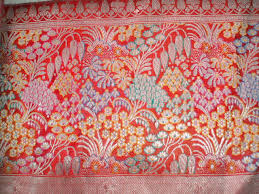"While Lucky was trying on the boots, she noticed a pretty young Indian woman in a red and white sari with an armload of packages struggling to keep track of her bags and her children while arguing with a salesman who had obviously not understood what she was looking for. What caught Lucky's attention was not just the saree but the particular style of sari the woman was wearing. It was a gara, a Parsi sari." ( P. 137)
Garas are traditional silk saris worn by Parsis on special occasions like weddings and Navjotes ( similar to the Christian Confirmation). These six yards of chamois silk are exquisitely hand embroidered in silken thread. What distinguishes this sari from other saris is the heavy embroidery
in which birds,weeping willows, tendrils and cranes twist and bend with infinite grace and fields studded with roses and peonies, jasmine and chrysanthemums. Within their folds the Parsi gara(as the sari is known), jhabla or jackets and kor or borders carry not just aesthetic images and cameos “painted with a needle” but tales and legends, myths and journeys of the Parsis, even the mystery of theKhakha or “forbidden stitch”, an embroidery stitch of such complexity that, according to legend, its execution can make the practitioner go blind
Traditionally, these saris were brought home by Parsi men travelling to China on business and who would bring home these treasures for their womenfolk. Garas were India’s first “fashion sari” in which “Anglicised” Parsi ladies stepped out to meet British memsahibs. Soon the gara became a must at all Navjots and a part of every Parsi girl’s trousseau, as well as a badge of Parsi identity.
The original gara had silk floss embroidery in white and occasionally in pastel shades on sal gajji silk, which was generally purple, red and black in colour. The embroidery was delicate and colour nuanced; often as many as 20-30 shades of a single colour thread were used to express one flower! The stitches were satin stitch with variations of extended, bound, voided and embossed as well as French knots. The Gujarat mochi stitch and zardosi from the Deccan were also incorporated while ari is now being used. A gara can take up to a year to create with many embroiderers working on one frame. Each is a “specialist” in one motif, which could be floral, a butterfly, bird…
However the symbols and motifs of each gara tell a story. The fleeing Parsis brought Persian symbols like the cypress tree, chakla chakli or contradictory birds, represented with delicacy. The Zoroastrian culture’s reverence for nature represented by trees and flowers, plant and fish life, the divine fungus, the bird of paradise and 30 flowers representing as many angels are other significant motifs while the lotus and peacock brings the fragrance of the Indian soil in which Parsi culture blossomed. While the Raj flavour incorporated floral baskets, the Chinese pheria stitched in vignettes of Chinese court life, beautiful gardens and flowers such as peony, rose, chrysanthemum... Some or all these motifs fill up a typical gara or jhablawith an overriding feel of harmony, richness, grandeur and delicacy.







No comments:
Post a Comment
Tell me what you think: